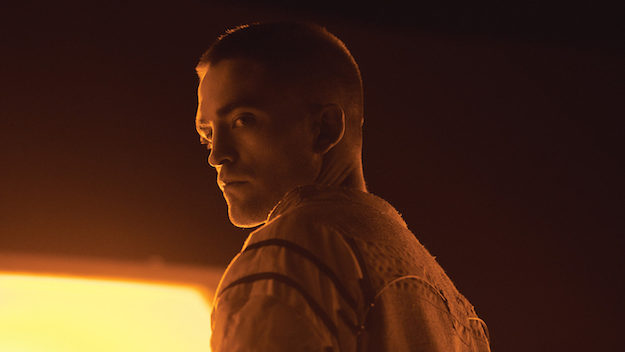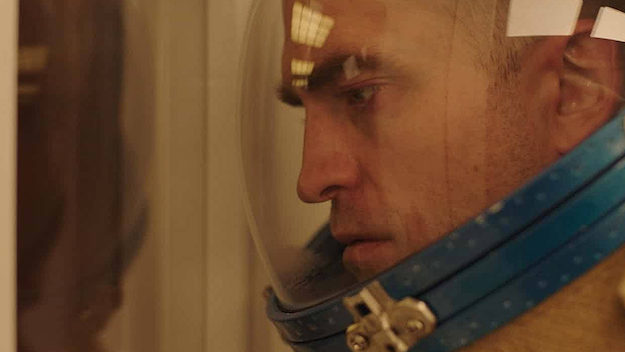Film of the Week: High Life

It would be a handy phrase to describe one of those elusive films that don’t quite congeal in ways that make stable sense: you could say such a film was “like Claire Denis in space.” And now, that’s what we’ve got: Claire Denis in space. High Life is Denis’s science fiction film—although it’s no more strictly an exercise in that genre than her Trouble Every Day was regular horror, her Bastards a by-the-book thriller, or Beau Travail a docudrama about the pressures of life in the modern Foreign Legion.
There’s an extraordinary shot of a black hole toward the end of High Life, resembling, as one character puts it, “a crocodile’s eye.” It’s composed of a whirl of shards of light massing round a central void, and in some ways that’s the encapsulating image of the film. High Life feels like a flood of fragmentary ideas—suggestive residues, perhaps, of multiple alternative films that Denis could have made, all circulating tantalizingly around the slippery central idea that might normally anchor a more conventional science-fiction drama. This, of course, makes High Life a typically perplexing and fascinating Claire Denis film. What do I think of it? I don’t know yet—and I’m happy to say that, since High Life is one of the significant offerings of a year in which some of the most rewarding films have been those that don’t yield their full meaning, or make their qualities entirely clear, on a first viewing. Another is Laszlo Nemes’s recent Sunset, while I happened to see High Life at the San Sebastian Film Festival on the very same day as Bi Gan’s mesmerizingly oneiric part-3D Long Day’s Journey Into Night. Little wonder that I’ve been feeling somewhat in free fall for the last 24 hours.
In space, they say, no one can hear you scream—but High Life lets you know that you can certainly hear a baby scream, and it would drive you nuts more easily in space than anywhere. If the film has anything like a central or founding premise, it’s this: a man looking after a baby alone on a spaceship. The man is Monte (Robert Pattinson), the last adult survivor of a mission to explore a black hole so as to find ways of harnessing its rotational power for energy on earth; the baby is Willow, a girl whose origins will become apparent later in the film. The first time we see her, she’s alone in a playpen communicating in gurgles with Monte over an intercom; he’s on the outside of the ship, conducting repairs. As soon as a particular piercing shriek of hers makes him drop a wrench, our sci-fi instincts—all those anxieties instilled by a lifetime of watching fictional spacewalks—kick in, and we imagine Monte too floating into space, leaving the baby alone. The fear of the void, unease about bad childcare: it’s a chillingly effective combination. When we later see Monte gently cradling the cooing baby, the feeling of reassurance is overwhelming: High Life draws on some intensely primal feelings.
High Life can genuinely be said to be one of the most awaited films in recent years, with Denis’s last feature—the oddly casual comedy of sexual manners Let the Sunshine In—feeling almost like an offhand holding gesture while we were waiting for the main attraction. It’s Denis’s first English-language film, which makes sense: we tend only to easily imagine interplanetary science fiction cinema in English or Russian (or at a pinch, Japanese or Polish). High Life was announced as an all-star venture with a script co-written by Zadie Smith and her partner Nick Laird—although they and Denis parted company quite early—and with visual input by Icelandic artist Olafur Eliasson, famous among other things for the vast “sun” he installed in London’s Tate Modern. As it stands, the script of High Life is credited to Denis, longtime collaborator Jean-Pol Fargeau, and Geoff Cox, a British writer who also worked on Lucile Hadzihalilovic’s Evolution. As for Eliasson, he and Denis worked on a short film, Contact (2014). That piece is a study in space, light and various shades of yellow, and that could be seen as a sort of unofficial preface to Denis’s feature—a thread picked up at the end of High Life, when a strip of yellow light slides down the screen like a Barnett Newman zip turned on its side, a prelude to the film’s final leap into the unknown.
The idea of a man and a baby girl alone in space, facing the most precarious of futures, is extremely rich in itself, and could easily have formed the substance of an entire film—perhaps of one of those pared-down, sparsely populated space dramas that get us pondering existential isolation. I’m thinking of John Carpenter’s Dark Star and Douglas Trumbull’s Silent Running—and the lushly damp-bejeweled hothouse foliage seen throughout High Life appears directly to echo that movie’s environmental imagery (a version of the artificial space jungle also appeared in Danny Boyle’s Sunshine, another desperate-journey drama).High Life’s images of a crop-haired Pattinson gently cradling a small child in a box floating in the void are haunting enough, but they just comprise the hub of a complex of mysterious imagery. We cut to episodes on Earth: images of children and a dog in a forest; grubby-faced, ragged youths hitching a ride on the outside of a train. The images feel unmistakably Tarkovskian—desolate and Siberian. It’s as if on Earth High Life is in the realm of Stalker; in space, where memory and hallucination stake their claim, in that of Solaris.

There’s also a bit of awkward exposition conducted between a scientist and a woman interviewing him on a train. What emerges from all these glimmers of information is that Monte is the last adult survivor of what’s essentially a suicide mission of the damned and condemned: one of a group of death row inmates sent as expendable guinea pigs on this black hole mission. There’s a young woman named Boyse (Mia Goth), an affable family man (André Benjamin, aka OutKast’s André 3000), an icily Nordic female pilot named Nansen (Agata Buzek). There’s a captain on the voyage (Lars Eidinger), but his body isn’t able to take the stress, leading to dramatic physical collapse. And there’s Dr. Dibs (Juliette Binoche), a medical officer with her own terrible secret, whose duties involve sampling the male voyagers’ semen in order to impregnate embryos; “I’m totally devoted to reproduction,” says the woman whom Monte dubs a “shaman of sperm.” It’s not spoiling anything to reveal that all these people are doomed. Early on, we see Monte packing their dead bodies into their spacesuits, after which they tumble one by one into space, each one falling silently into black nothingness—the silence accentuated by some clever sound design emphasizing the surrounding rustle—before their bodies fall together in a vertical formation, like a rain of businessmen in a Magritte painting.
If the black hole is the void that the film is overtly headed towards, its counterpart is an excessive plenitude in the shape of the “Fuckbox,” a sort of Orgasmatron device into which the travelers step for sexual satisfaction (all except Monte, who for his own reasons, has taken a monastic vow of chastity). Dibs is the first person seen using it, which allows Binoche to vent her physicality—as she sometimes has in film, in photos, and in dance—to extreme athletic effect. There’s a dildo-like metal extension involved, but there’s more to it than that; as Binoche writhes in the dark, Yorick Le Saux’s camera mapping every muscular contortion of her naked back, she seems to be riding a furry bucking bronco, while a milky fluid seeps from the machinery. This is the most delirious element of a film that’s otherwise contemplative: a performance-meets-installation nightmare moment, with perhaps a touch of Matthew Barney. There’s also, it should be said, a sudden outburst of violence that accounts for the death of one more crewmember, while another gets killed on a reckless venture that leaves them stretched badly out of shape: that, apparently, is what black holes will do for you.
The production designer is François-Renaud Labarthe, although Eliasson seems to be responsible for some of the lighting effects. There’s more wood visible on this spaceship than we are normally used to, especially in the corridors, which seem to warp and degrade as time progresses—and which also therefore help us negotiate the narrative’s leaps between past, present, and future. The ship itself is no streamlined capsule but resembles a goods crate, and a space sequence in which the ship docks with another, its exact replica, is at once uncanny (at first, we’re not certain whether the vessel has actually met itself, through some effect of a time warp) and sobering, as we realize that this mission and the people in it are just expendable pieces in a much bigger program. The other ship, incidentally, seems to have ended its voyage in a differently dramatic fashion, and again a rather Tarkovskian one: it’s like another brief glimpse of a parallel film that we haven’t seen.
High Life is bound, like most Denis films, to be discussed and deconstructed in detail, and like most of her films, I suspect we won’t be clear about what it really is for some time (think of 35 Shots of Rum, which seemed like a sweet bagatelle on first viewing and gradually emerged as one of her most substantial works). For now, I’ll settle for saying that the shock and richness of High Life are wonderfully enchanting and perplexing, and that even if much of the film seems to re-map familiar territory, it does so in unfamiliar ways; its DNA, let’s say, is substantially but subtly deviant.
Central to the film is the idea of “taboo,” a word that Monte repeats at the start, explaining to little Willow that people shouldn’t drink their own piss or eat their own shit, even if they don’t resemble piss and shit: that’s taboo. People do seem to drink their own piss on this voyage—a water recycling system plays a significant part—but perhaps there’s an ironic comment here about the undesirability of recycling science-fiction tropes unless you can bring something radically new and freshening into play. High Life doesn’t—not overtly, at least—go into the areas of taboo we might expect or fear, but it does suggest that there’s much to be gained from crossing certain lines. “Break the laws of nature and you pay for it,” Monte comments early on. But at the very end of the film, he says to someone, “Shall we?” And they reply, “Yes.” It’s an enticing invitation, and a typically Denisian challenge.
High Life screens October 2 and 4 in the New York Film Festival.
Jonathan Romney is a contributing editor to Film Comment and writes its Film of the Week column. He is a member of the London Film Critics Circle.







